The Twenty-first United States Congress was a meeting of the legislative branch of the United States federal government, consisting of the United States Senate and the United States House of Representatives. It met in Washington, D.C. from March 4, 1829 to March 4, 1831, during the first two years of Andrew Jackson's presidency. The apportionment of seats in the House of Representatives was based on the Fourth Census of the United States in 1820. Both chambers had a Jacksonian majority.
March 4, 1829: Andrew Jackson became President of the United StatesMay 28, 1830: Indian Removal Act, ch. 148, 4 Stat. 411May 27, 1830: Maysville Road Bill vetoedSeptember 27, 1830: The Treaty of Dancing Rabbit Creek, the first removal treaty after the passage of the Indian Removal Act, is signed with the Choctaw.February 24, 1831: Treaty of Dancing Rabbit Creek proclaimed.The count below identifies party affiliations at the beginning of the first session of this Congress. Changes resulting from subsequent replacements are shown below in the "Changes in membership" section.
President: John C. Calhoun (J)President pro tempore: Samuel Smith (J)Speaker: Andrew Stevenson (J)This list is arranged by chamber, then by state. Senators are listed in order of seniority, and Representatives are listed by district.
Skip to House of Representatives, belowSenators were elected by the state legislatures every two years, with one-third beginning new six-year terms with each Congress. Preceding the names in the list below are Senate class numbers, which indicate the cycle of their election. In this Congress, Class 1 meant their term began in the last Congress, requiring reelection in 1832; Class 2 meant their term began with this Congress, requiring reelection in 1834; and Class 3 meant their term ended with this Congress, requiring reelection in 1830.
The names of members of the House of Representatives are preceded by their district numbers.
The count below reflects changes from the beginning of the first session of this Congress.
Replacements: 4Jacksonians (J): no net changeAnti-Jacksonians (AJ): no net changeDeaths: 4Resignations: 4Interim appointments: 1Total seats with changes: 7Replacements: 5Jacksonians (J): 1 seat net lossAnti-Jacksonian (AJ): 1 seat net gainDeaths: 2Resignations: 10Contested election: 2Total seats with changes: 15
Lists of committees and their party leaders.
Accounts of James Monroe (Select)AgricultureAmending the Constitution on the Election of the President and Vice President (Select)Audit and Control the Contingent Expenses of the SenateClaimsCommerceDistributing Public Revenue Among the States (Select)District of ColumbiaDueling (Select)FinanceForeign RelationsFrench Spoilations (Select)Impeachment of James H. Peck (Select)Indian AffairsJudiciaryManufacturesMemorial of the Manufacturers Iron (Select)Mileage of Members of Congress (Select)Military AffairsMilitiaNaval AffairsNomination of Amos Kendall (Select)PensionsPost Office Department (Select)Post Office and Post RoadsPrivate Land ClaimsPublic LandsRoads and Canals (Select)Tariff Regulation (Select)WholeAccountsAgricultureAmerican Colonization Society (Select)ClaimsCommerceDistrict of ColumbiaElectionsEstablishing an Assay Office in the Gold Region (Select)Expenditures in the Navy DepartmentExpenditures in the Post Office DepartmentExpenditures in the State DepartmentExpenditures in the Treasury DepartmentExpenditures in the War DepartmentExpenditures on Public BuildingsForeign AffairsIndian AffairsManufacturesMilitary AffairsMilitary PensionsNaval AffairsPost Office and Post RoadsPublic ExpendituresPublic LandsRevisal and Unfinished BusinessRevolutionary ClaimsRules (Select)Standards of Official ConductTerritoriesWays and MeansWholeEnrolled BillsArchitect of the Capitol: Charles Bulfinch, until June 25, 1829 (office abolished)Librarian of Congress: John Silva MeehanChaplain: William Ryland (Methodist)Henry V. Johns (Episcopalian), elected December 14, 1829Secretary: Walter LowrieSergeant at Arms: Mountjoy BaylyChaplain: Reuben Post (Presbyterian)Ralph R. Gurley (Presbyterian), elected December 6, 1830Clerk: Matthew St. Clair ClarkeDoorkeeper: Benjamin BirchSergeant at Arms: John O. Dunn 
